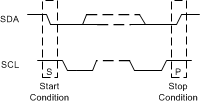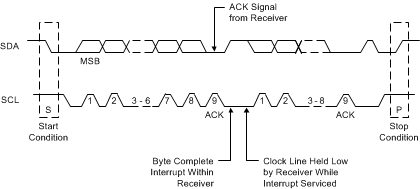JAJSI48C March 2017 – October 2019 LMH1228
PRODUCTION DATA.
- 1 特長
- 2 アプリケーション
- 3 概要
- 4 改訂履歴
- 5 Pin Configuration and Functions
- 6 Specifications
-
7 Detailed Description
- 7.1 Overview
- 7.2 Functional Block Diagram
- 7.3
Feature Description
- 7.3.1 4-Level Input Pins and Thresholds
- 7.3.2 OUT0_SEL and SDI_OUT2_SEL Control
- 7.3.3 Input Signal Detect
- 7.3.4 Continuous Time Linear Equalizer (CTLE)
- 7.3.5 Clock and Data (CDR) Recovery
- 7.3.6 Internal Eye Opening Monitor (EOM)
- 7.3.7 Output Function Control
- 7.3.8 Output Driver Control
- 7.3.9 Status Indicators and Interrupts
- 7.4 Device Functional Modes
- 7.5 Register Maps
- 8 Application and Implementation
- 9 Power Supply Recommendations
- 10Layout
- 11デバイスおよびドキュメントのサポート
- 12メカニカル、パッケージ、および注文情報
パッケージ・オプション
メカニカル・データ(パッケージ|ピン)
- RTV|32
サーマルパッド・メカニカル・データ
- RTV|32
発注情報
7.4.1.1 SMBus Read and Write Transaction
SMBus is a two-wire serial interface through which various system component chips can communicate with the master. Slave devices are identified by having a unique device address. The two-wire serial interface consists of SCL and SDA signals. SCL is a clock output from the master to all of the slave devices on the bus. SDA is a bidirectional data signal between the master and slave devices. The LMH1228 SMBus SCL and SDA signals are open-drain and require external pullup resistors.
Start and Stop:
The master generates Start and Stop patterns at the beginning and end of each transaction.
- Start: High-to-low transition (falling edge) of SDA while SCL is high.
- Start: High-to-low transition (falling edge) of SDA while SCL is high.
 Figure 12. Start and Stop Conditions
Figure 12. Start and Stop Conditions The master generates nine clock pulses for each byte transfer. The 9th clock pulse constitutes the ACK cycle. The transmitter releases SDA to allow the receiver to send the ACK signal. An ACK is recorded when the device pulls SDA low, while a NACK is recorded if the line remains high.
 Figure 13. Acknowledge (ACK)
Figure 13. Acknowledge (ACK)